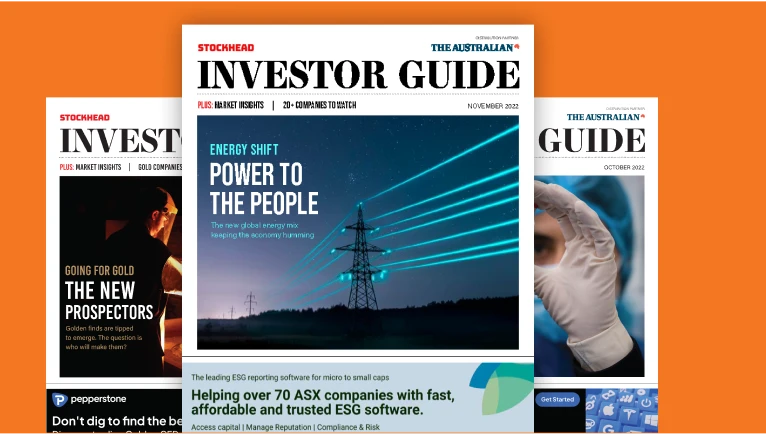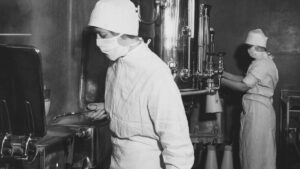Scott Power: ASX health stocks up in mixed earnings season, Mayne surges on $672 million US buyout

Pic: Getty Images
- ASX health stocks up 0.83% over the past week, while the broader market falls 2.62%
- Morgans upgrades Nanosonics after 18% H1 FY25 revenue lift
- US pharmaceutical company Cosette set to buy drug maker Mayne Pharma in deal worth $672 million
Healthcare and life sciences expert Scott Power, who has been a senior analyst with Morgans Financial for 27 years, gives his take on the ASX healthcare sector for the week and his ‘Powerplay’ stock pick.
In a big week for half-year healthcare results, sector expert Scott Power says performance across the ASX-listed players has been mixed.
After being down for most of the week the ASX health sector recovered on Friday. At 11.30am (AEDT) on Friday, the S&P/ASX 200 Health Care index (ASX:XHJ) was up 0.83% for the past five days, while the benchmark S&P/ASX 200 (ASX:XJO) fell 2.62% for the same period.
Global geopolitical and macroeconomic factors continue to play on the local markets. A decision by the Reserve Bank of Australia (RBA) to cut interest rates by 0.25 percentage points to 4.1% on Tuesday did not even elicit excitment.
“The interest rate cut in Australia didn’t seem to inspire the market here,” Power said.
“The market is still being driven with what is happening around the world with US President Donald Trump and his various movements.
“China’s growth trajectory is also still uncertain so there are big picture things investors are focused in on.”
Morgans upgrades Nanosonics
Infection prevention company Nanosonics (ASX:NAN) rose more than 16% on Thursday after releasing its H1 FY25 results.
Nanosonics reported half year total revenue of $93.6 million, an increase of 18% on prior corresponding period (pcp) and half year capital revenue of $24.4m, up 11% on pcp with consumables/service revenue up 20% to $69.2m.
Specialising in automated decontamination of reusable medical instruments such as ultrasound and endoscopes, Nanosonics Trophon technology for ultrasound decontamination has become standard of care in several countries, including the US, Australia and UK.
Morgans healthcare analyst Iain Wilkie said “pleasingly” the company added 1050 new Trophon units to its install base in H2 FY25, despite being a 5% decrease from H1 FY24.
“Our pass-mark sat at +1000 units so we are happy with this result which we view as indicating that hospital budgetary pressures are stabilising,” Wilkie wrote in a note to clients.
Nanosonics said its new endoscope cleaning technology CORIS continued to proceed through the US Food and Drug Administration (FDA) de novo review process with the target for first commercial launch remaining in Q1 FY26.
“Overall, a good result with upgrades to guidance and commentary around CORIS approval continues to be positive,” Wilkie wrote.
Morgans has upgraded its rating for Nanosonics to add from a hold and increased its 12-month target price to $4.50 from $3.75.
US-based Cosette to buy Mayne Pharma for $672 million
Mayne Pharma (ASX:MYX) was up 32% on Friday after inking a deal to be sold to US pharmaceutical company Cosette for an equity value of $672m.
The Adelaide-based drugmaker said in an ASX announcement on Friday that it had agreed to a scheme of arrangement at $7.40 per share, a 37% premium on its Thursday closing prices.
Cosette has a portfolio of products in women’s health and dermatology, with corporate and manufacturing facilities in New Jersey and North Carolina in the US.
“We are pleased that Cosette has recognised significant value in Mayne Pharma, particularly in our women’s health and dermatology businesses, and the offer provides shareholders with the opportunity to receive cash value at a significant premium,” chairman Frank Condella, said.
The scheme is fully funded and subject to regulatory approvals, including that of Mayne Pharma shareholders and an independent expert’s report.
Power’s Powerplay: Polynovo to report half-year results
PolyNovo (ASX:PNV) is Power’s pick of the week with the wound care company due to report its H1 Fy25 results next Monday.
PolyNovo has seen its share price fall more than 25% in the past six months.
“That share price has been weak for a few months now despite them releasing their first half revenue results of around $60 million, which was quite a reasonable number,” Power said.
“When they report on Monday there should be a reasonably good share price reaction is my expectation.”
Morgans currently has an add rating on PolyNovo with a 12-month target price of $2.85.
Sonic and Healius fall on H1 FY25 results
Pathology and radiology giant Sonic Healthcare (ASX:SHL) fell ~3% on Thursday after releasing its H1 FY25 results, despite underlying profit in line with consensus and Morgans estimates.
EBITDA was $827m, up 12% on pcp and revenue of $4.669 billion, rose 8% on pcp. Sonic said organic revenue growth and cost reduction programs, particularly labour, drove margin expansion.
The company said synergy initiatives from acquisitions were on track with the majority of benefits in future periods.
Sonic said it remained on track to achieve full-year EBITDA guidance provided in August 2024 of $1.70–1.75 billion on a constant currency basis.
Morgan’s has an add rating on Sonic and a current 12-month target price of $32.21.
Meanwhile, pathology provider Healius (ASX:HLS) fell 6% on Thursday after posting a mixed result, including a net loss of $12.8m for the first half.
Group revenue $933.9m was a 10% increase year-on-year, with underlying EBITDA up 3.3% to $164.4m, and underlying EBIT up 51% to $23.7m.
In September 2024 Healius announced its Lumus Imaging business would be sold to Affinity Equity Partners for an enterprise value of $965m.
In its latest results Sonic said completion of the deal was anticipated to occur in the next half, subject to a number of conditions, including Foreign Investment Review Board approval.
Power said the results of both Sonic and Healius were “a bit of a downdraft on the share price.”
Solid result for EBOS, profit taking coming through
Power’s Powerplay from last week EBOS Group (ASX:EBO) reported its H1 FY25 result on Wednesday with the pharmaceutical distributor reporting EBITDA of $291m, in line with consensus, and above Morgans estimate of $283.6m.
Importantly, Power said FY25 guidance of underlying EBITDA between $575m to A$600m was reconfirmed.
The company reported (ex-Chemist Warehouse) revenue of ~$6bn, up 9.5% on pcp, underlying EBITDA of $29m, up 7.1% on pcp and EBIT of $236m, up 7.8% on pcp.
EBOS lost a wholesale supply contract to supply Chemist Warehouse, which listed on the ASX last week through its merger with Sigma Healthcare (ASX:SIG), from July 1, 2024.
EBOS said it made strong progress on its near-term growth strategies. The company also announced long-term CEO John Cullity would retire on June 30, 2025 being replaced by Orica executive Adam Hall.
The company declared an interim dividend declared of NZ 57 cents per share, maintained at the H1 FY24 level. The company’s share price has fallen ~7% in the past five days.
“I think with EBOS there’s been a bit of profit taking coming in as it has had a good run,” Power said.
Morgans maintains an add rating on EBOS but has reduced its 12-month target price from $39.04 to $38.56.
Research Corner: Humans beat AI in disease coding test
Who outperformed in a James Cook University-led study pitching five human clinical document coders up against ChatGPT-based large language models to analyse 100 randomly selected challenging clinical patient summaries across five major categories of diseases?
Well, the results are in and the humans win. The top human coder in the study achieved 47% accuracy, while ChatGPT achieved 22%.
“We saw a couple of human coders perform better in almost all cases than the tool,” said study lead author and JCU PhD candidate Akram Mustafa.
“Some of the coders performed worse, but if you put the combined five categories together, overall human coders do better.”
Coders translate health records into standardised alphanumeric codes, which are then used for state and commonwealth data reporting, health service planning and hospital funding models.
Mustafa said while previous studies had compared human coders to AI in classifying medical documents, this study went a step further.
“Some clinical cases are easy to classify where previous machine learning models or normal mapping tools can already do well,” he said.
“But we wanted to look at cases where it’s challenging for those mainstream tools to classify clinical documents into different disease categories.”
Study co-author and JCU Electronics and Computer Engineering Professor Mostafa Rahimi Azghadi said the team also compared the performance of ChatGPT 3.5 with ChatGPT 4 during the study, finding the latter produced far more consistent disease classifications when repeatedly fed the same clinical documents.
Azghadi said the model should be viewed as a tool that could complement human coding, particularly in reducing inconsistencies and improving efficiency.
“A hybrid approach could be to leverage a large language model’s speed and ability to flag difficult cases and combine it with human oversight for scenarios where the classification is more difficult,” he said.
Azghadi said the next step would be to add more explainability in the model where it could provide a more detailed justification for why it has classified a patient with a particular condition.
The views, information, or opinions expressed in the interview in this article are solely those of the interviewee and do not represent the views of Stockhead.
Stockhead has not provided, endorsed or otherwise assumed responsibility for any financial product advice contained in this article.
Disclosure: The journalist held shares in Sonic Healthcare at the time of writing this article.

UNLOCK INSIGHTS
Discover the untold stories of emerging ASX stocks.
Daily news and expert analysis, it's free to subscribe.
By proceeding, you confirm you understand that we handle personal information in accordance with our Privacy Policy.








